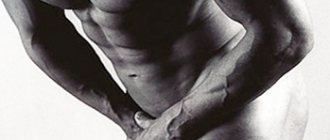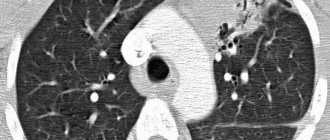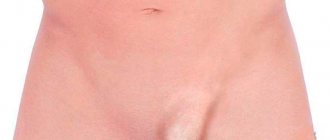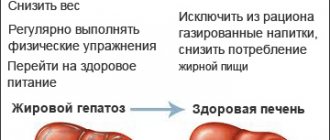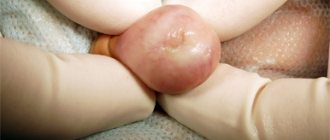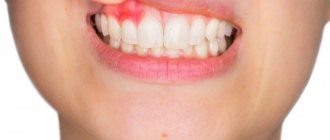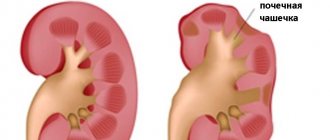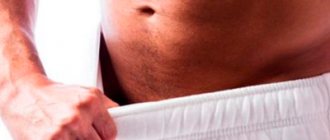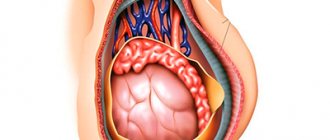Publication date: November 25, 2020
Inflammation of the lymph node under the arm is a sign that makes itself felt almost immediately. The fact is that the inflammatory reaction is accompanied by significant swelling, so even with a slight touch, the inflamed lymph nodes under the arm will hurt. As a rule, axillary lymphadenitis most often occurs after a respiratory illness. Therefore, if such a complication occurs, it is necessary to seek help from a qualified specialist as soon as possible.
Types of lymph nodes
Small lymph nodes are located throughout the body. Located nearby, they form groups and chains. The main groups of lymph glands are found in the neck, armpits and groin area, as well as in many other places in the body. Lymph nodes are connected to each other by lymph channels. Lymphatic fluid is formed between the cells of the body. This watery fluid travels along channels through the glands and eventually enters the bloodstream. Lymph nodes are a major part of the immune system. They contain former blood cells (lymphocytes) and antibodies that protect the body from infections.
Causes of inflammation of the lymph nodes
In most cases, inflammation of the lymph nodes occurs as a consequence of one or another disease of the body. There are two types of disease: nonspecific and specific lymphadenitis.
The cause of nonspecific is pathological processes that develop against the background of viruses and infections entering the body. Periodontitis, abscesses, advanced carious processes, tonsillitis, colds, toxoplasmosis, foci of suppuration and even allergic reactions are a “favorable” background for the occurrence of nonspecific lymphadenitis. Inflammation of the lymph nodes under the armpit in most cases also belongs to this type.
The causes of specific lymphadenitis are severe infections: AIDS, mononucleosis, tuberculosis, leukemia, etc.
Main reasons
Infection
As the immune system fights bacteria and viruses, the lymph nodes swell and become soft. They return to normal size only when the immune system has completely defeated the infection. May last about a week. Common infections include the following:
- Throat, colds and tooth infections
- Skin diseases on the head, including lice, can cause swelling in the occipital region
- Skin diseases of the hands can lead to inflammation in the axillary area
- Infections in the legs and genital area usually lead to enlarged lymph nodes in the groin area
- Viral infections such as influenza, chickenpox, and mononucleosis affect the entire body.
Cancer, lymphoma, leukemia
Less common cause. Cancer cells can metastasize to nearby lymph nodes through the lymphatic channel. These cancer cells can live and spread in the lymph glands and cause swelling. Types of cancer that cause inflammation:
- Mammary cancer
- Throat cancer
- Lung and stomach cancer
- Skin cancer
- Cancer of the lymphatic and circulatory system
- As a rule, enlarged lymph nodes for this reason cause less discomfort and may be painless at an early stage.
Other, less common causes
Rarely, swelling is associated with a reaction to certain medications and with diseases such as sarcoidosis and some forms of arthritis. The problem can also be caused by Kawasaki disease, HIV and tuberculosis.
Treatment of lymphadenitis
The main thing that the patient should know and take into account is the inadmissibility of self-treatment. Under no circumstances should you try to stop the disease yourself. Only a doctor prescribes the necessary treatment tactics, and it consists of conducting the correct etiotropic and pathogenetic therapy. As a rule, all efforts of the doctor and the patient are directed toward eliminating the source of inflammation that provoked the development of axillary lymphadenitis. Most often, the doctor prescribes anti-inflammatory drugs and prescribes antibacterial therapy. It is also advisable to use compresses with Dimexide, physiotherapeutic treatment, and immunomodulators. All this helps the body to get stronger and cope with the disease that has arisen. If a malignant process arises and develops and is accompanied by axillary lymphadenitis, then the patient must undergo a course of chemotherapy or surgery will be indicated.
What to do if the lymph nodes are enlarged
Enlargement due to infection is common and does not require special attention. For example, with frequent throat diseases, the lymph nodes swell in the neck. You should be concerned if the nodes have increased without any obvious reason. In this case, you should consult a doctor. You may also need to see a doctor if the swelling does not go away within two weeks.
See also: Inflammation of the lymph nodes in the neck - treatment
We invite you to familiarize yourself with the ESMA line of medical devices.
Symptoms of axillary lymphadenitis
Inflammation in the regional axillary lymph nodes is isolated, accompanied by catarrhal symptoms and suppuration. Next, the most common clinical pictures of axillary lymphadenitis will be presented.
- Acute catarrhal form. It occurs more often than other forms and usually has a mild course. Lymph nodes in this form of the disease are enlarged, painful, compacted, they are easily separated and do not cease to be mobile. The tissues in the armpit are hyperemic and there is slight swelling. The patient may feel a deterioration in general condition, slight low-grade fever and discomfort when moving the shoulder.
- Purulent form. Such inflammation is extremely dangerous, as it is accompanied by the formation of a purulent focus consisting of single or multiple abscesses. The node itself ceases to be mobile, pain and swelling appear. The tissues located next to the source of inflammation are hyperemic, and alternative processes or melting may begin. Soldering of inflamed nodes with the skin may also occur.
- Chronic form of lymphadenitis. This is a common, indolent form of the disease, which is accompanied by inflammation of the axillary lymph node. Occurs when the body is weakened, immunity decreases, and resistance to infections decreases. Symptoms of chronic axillary lymphadenitis do not have a pronounced picture: the nodes retain their mobility, but the patient feels slight pain.
Folk remedies
Among the time-tested folk remedies, we can highlight the following recipes:
- Fresh celery leaves are washed in warm water, kneaded and applied to the affected area several times a day;
- Fresh plantain leaves are thoroughly kneaded in your hands until the juice begins to release. After this, they are applied to hidradenitis under the armpit for 15-20 minutes 3-4 times a day. Fresh plantain juice also has good effectiveness;
- Aloe vera leaves are thoroughly washed with warm water, cut lengthwise and applied to the affected area. Aloe leaves themselves are not able to cure the disease, but they have a bactericidal effect and are perfectly combined with other remedies;
- One teaspoon of chamomile, sage, eucalyptus or calendula flowers is poured into a glass of boiling water. Then the solution is filtered and infused for 24 hours. The inflamed area should be washed several times a day.
If a person is diagnosed with hidradenitis, alternative treatment can successfully replace surgical and other traditional methods, but before using decoctions and infusions, consult your doctor or consult an experienced homeopath.
Diagnostics
Visual examination of the patient and history taking are important. After this, the doctor prescribes a detailed blood test and x-ray or computed tomography. This is done to exclude tumor diseases. In severe cases, a lymph node biopsy is prescribed.
To identify the causes of inflammation of the inguinal lymph nodes, the doctor will recommend a general urine test, as well as testing for syphilis, hepatitis and HIV infection.
On our website you will find information regarding the diagnosis and treatment of lymphadenitis. In addition, you have the opportunity to schedule a consultation with a specialist and learn how to treat inflammation of the lymph nodes behind the ear.
Hygiene rules
Maintaining good hygiene when dealing with hidradenitis helps prevent the infection from spreading to other areas of the body. In addition, microorganisms that get from the wound onto the hands or into the environment can cause severe poisoning or purulent inflammation in other family members.
- You can't take a bath. This can promote the spread of pus throughout the body. Instead, shower once a day, after covering the affected area with adhesive tape to prevent water from getting on it.
- The patient must have his own towel, underwear and bed linen. It must be washed daily at a temperature of at least 90 degrees and ironed with a hot iron.
- For hygiene of inflamed areas, you can use Citeal instead of liquid soap.
- When washing, use germicidal soap or gel with a high lactic acid content. Such products will help reduce the number of pathogenic microbes on the skin and normalize its acidity.
- Until complete recovery, avoid shaving and hair removal to avoid damaging the skin.
- Wear loose clothing made from natural materials. They help avoid overheating and excessive sweating, which increase the proliferation of bacteria and increase the source of inflammation.
- After a shower, wash the affected areas with a slightly pink solution of potassium permanganate.
To dry skin folds with hidradenitis, it is recommended to use powders with zinc oxide and talc.
Reviews
Some reviews from people who have encountered the problem of hidradenitis.
- Review from Oksana. I had hidradenitis in 2009. I underwent 4 operations in a year. Vitamins, autohemotherapy, ointments... it only helped for a while, and then it became inflamed again. I turned to the professor in the purulent-septic department. They performed an operation, but they didn’t just make an incision and that’s it, but radically, it turned out to be a deep excision. then they administered a course of antibiotics into a vein, to which the culture from the wound was sensitive. Only after 12 days of such therapy was I discharged. and all is well. There is, however, a noticeable seam left, but these are minor things. recommended: wipe with alcohol periodically, do not overcool, remove gel or roll-on deodorants, hygiene. and they also advised everyone - maybe it will help someone, especially those who have not yet consulted a surgeon - mix laundry soap (grate), warm baked onion (chop). mix. on the inflamed area, cover with a bandage (change 2 times a day). draws out pus very well.
- Review from Ian. Yeahhh..this is complete crap! I've cut myself 7 times already!!! But for the last 5 times I haven’t gone to the doctor. Don’t think that I’m urging you not to apply, it’s just that the procedure is quite painful! What I do: I burn my buds with boric acid, iodine, smear them with chlorhexidine, apply bandages with baneocin ointment (this is an ointment intended for the treatment of hidradenitis), drink the antibiotic amoxicillin or amoxiclav (amoxiclav costs 500 rubles, and the first up to 100 rubles, the effect almost the same) and brewer's yeast. Burning procedures are painful!!! Very! But it's worth it! Going to the doctor is even more scary! This crap has been tormenting me for 2 years now! I’m so tired that I have no strength! I hate this disease! Surgeons cut with such pleasure! When asked what to do and why this happens, they answer that just cut and don’t catch a cold! But this is not a solution! That’s why we have to take such extreme measures... And now a relapse has occurred:((( I hope that everything will work out!... just like last time.. I wish everyone not to get sick!!!
Physiotherapeutic procedures
Physiotherapeutic procedures for hidradenitis:
- Ultrahigh-frequency therapy (UHF) helps reduce inflammation and eliminate infiltration. The procedure is prescribed if hidradenitis is surrounded by a dense infiltrate and its center is not prone to softening. Physiotherapy in this case is accompanied by the use of antibiotics.
- Sunbathing for 20-30 minutes or heating with a blue lamp for 5 minutes at a distance of 15-20 cm. Dry heat improves blood circulation and promotes the resorption of seals.
- Centimeter wave therapy (CW) therapy improves microcirculation and relieves swelling, reduces signs of inflammation, and increases the protective properties of the skin.
- X-ray therapy is used to destroy the inflamed sweat gland in recurrent hidradenitis.
- Local ultraviolet irradiation (UVR) causes the death of bacteria and increases local immunity and skin resistance to infections.
Once a cavity filled with pus has formed inside the source of inflammation, maturing procedures are contraindicated.
Symptoms of hidradenitis
The beginning is gradual. At the site of inflammation, an itching sensation occurs, and a dense, very painful swelling appears with a diameter ranging from a few millimeters to 1-2 centimeters.
Gradually the size of the swelling and pain increase. The skin over it turns purple-red. The center of the swelling gradually softens, opens, and pus begins to be released through the resulting hole. The development cycle of infiltration lasts 10-15 days. Resolution of hidradenitis ends with the formation of a scar. Often neighboring sweat glands are involved in the inflammation process.
In this case, an extensive, very painful infiltrate is formed, the skin over which becomes lumpy. With successive damage to more and more sweat glands, the process drags on for a month or more. Hidradenitis is often accompanied by symptoms of general intoxication, hyperthermia, cephalgia, and leukocytosis.
Prevention of inflammatory processes
Lymphadenitis, as noted above, is a secondary disease. Therefore, in order to avoid colds and viral diseases, we recommend strengthening your immune system, eating well, exercising and giving up bad habits. We advise parents of children to promptly treat abrasions on the arms and legs with antiseptics, and if necessary, consult a pediatrician. By the way, the latter will tell you which doctor treats inflammation of the parotid lymph nodes, which is quite common in childhood.
If you still have questions after reading the article, please contact our medical center. You can make an appointment at any time convenient for you. Our specialists will advise and, if necessary, recommend one or another examination. You will also receive an answer to the question “what to do if the lymph nodes in the jaw are inflamed.” Contact us – the center is open 24 hours a day, seven days a week.
Related services: Consultation with a pediatrician Consultation with a family doctor
Causes
The main cause of the disease is Staphylococcus aureus and white.
- When bacteria penetrate into the excretory ducts of the sweat glands, they begin to multiply.
- The sweat gland duct is blocked by a horny plug.
- the produced secretion, which has no outlet to the outside, stretches the gland.
- the accumulated secretion is a good breeding ground for bacteria to multiply.
- the sweat gland becomes inflamed and the duct ruptures.
- the infection spreads to surrounding tissues. Fistula tracts are formed.
However, the entry of staphylococcus occurs only in the presence of predisposing factors:
- increased sweating;
- the presence of microtraumas to the skin resulting from careless shaving or scratching;
- weakening of the body's defenses (decreased immunity);
- failure to comply with personal hygiene rules;
- endocrine diseases such as diabetes mellitus, exogenous constitutional obesity.
Hidradenitis, localized in the armpit, occurs more often in women than in men. In old age, the occurrence of hidradenitis practically does not occur, since at this age the sweat glands no longer function well.

